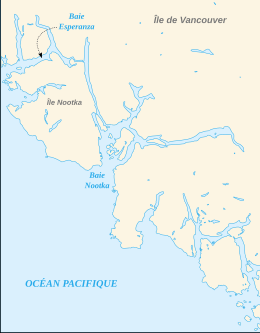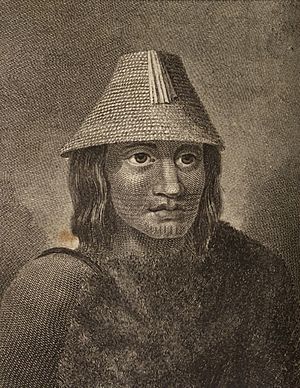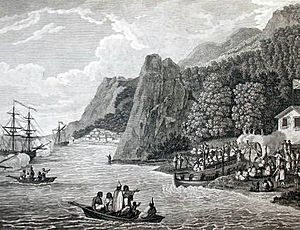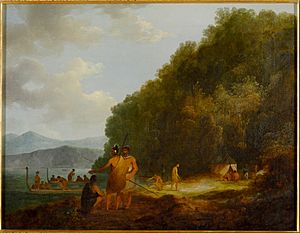Nootka Sound facts for kids
Quick facts for kids Nootka Sound |
|
|---|---|
| French: Baie de Nootka | |
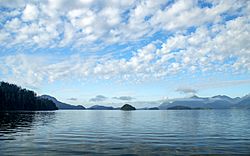
Clouds over Nootka Sound
|
|
| Lua error in Module:Location_map at line 420: attempt to index field 'wikibase' (a nil value). | |
|
Map of Nootka Sound
|
|
| Location | Vancouver Island, British Columbia |
| Type | Sound |
| Native name | Mowichat Error {{native name checker}}: parameter value is malformed (help) |
| Ocean/sea sources | Pacific Ocean |
| Settlements | Gold River, Tahsis, Yuquot, Zeballos |
Nootka Sound is a large inlet of the Pacific Ocean. You can find it on the west coast of Vancouver Island. This island is part of British Columbia, a province in Canada.
Nootka Sound is a beautiful area with a rich history. It was once known as King George's Sound. This place was very important for the maritime fur trade long ago. It also separates Vancouver Island from Nootka Island.
Contents
Exploring Nootka Sound's Past
Nootka Sound is the traditional home of the Nuu-chah-nulth people. They are an indigenous group who called this place Mowichat. An Englishman named John R. Jewitt lived here as a captive. He was with Chief Maquinna from 1802 to 1805. Jewitt wrote a book about his time there. It tells us a lot about the area.
Early European Visits and Trade
The first Europeans to visit Nootka Sound were from Spain. On August 8, 1774, a Spanish ship called Santiago arrived. It was led by Juan Pérez. The Spanish sailors did not land. But local natives came to their ship in canoes. They traded furs for abalone shells. Pérez named the entrance to the sound Surgidero de San Lorenzo.
In March 1778, Captain James Cook of the Royal Navy landed nearby. He named the inlet "King George's Sound". Cook wrote down the native name as Nutka or Nootka. He might have misunderstood what the locals told him. They might have been saying they were on an island. Or it could have been a misunderstanding of Nuu-chah-nulth, their own name for themselves. The name Nootka stuck, and the older Spanish and British names were forgotten.
At that time, Spain controlled most trade between Asia and North America. But Russia was also starting to trade furs in Alaska. Both Spain and Great Britain became more active in the Pacific Northwest.
The next European trader to visit Nootka Sound was James Hanna in 1785. He was British. Hanna traded iron bars for furs. He then sold these furs in China for a huge profit. This started the important Maritime fur trade in the area.
In 1786, another fur trader, James Strange, visited. One of his crew, John Mackay, stayed behind. Mackay wanted to build relationships with the locals. He learned their language and customs. He even married a young native girl. But Strange never returned. When Charles Barkley arrived in 1787, he found Mackay. Mackay joined Barkley's ship, the Imperial Eagle.
The Nootka Crisis: A Near War
From 1774, Spain sent ships to Alaska. They wanted to show their claim over the Pacific Northwest. This claim dated back to the 1500s. Between 1785 and 1795, British traders also tried to set up fur trading posts. They had support from their government. But Spain did not like this.
In 1789, Spain sent Esteban José Martinez to Nootka Sound. He was there to protect Spain's claims. Martinez built a fort called Fort San Miguel. He also seized some British ships. Two American ships were allowed to leave because the United States was Spain's friend. But one American ship was later seized too.
The capture of the British ships almost led to a war. This event is called the Nootka Crisis. Britain argued that Spain did not own all the land on the Pacific Coast. The first Nootka Convention was signed in 1790. It allowed both countries to settle along the Pacific coasts. This was the first time Spain's control was broken in over 200 years.
The Nootka Sound disagreement also affected the French Revolution. The Spanish king asked France for help against Britain. But the French king, Louis XVI, had less power now. The French National Assembly said the king could not declare war alone. This was a big change for the monarchy.
Weather at Nootka Sound
| Climate data for Nootka Lightstation | |||||||||||||
|---|---|---|---|---|---|---|---|---|---|---|---|---|---|
| Month | Jan | Feb | Mar | Apr | May | Jun | Jul | Aug | Sep | Oct | Nov | Dec | Year |
| Record high °C (°F) | 18.5 (65.3) |
16.5 (61.7) |
18.5 (65.3) |
23 (73) |
27.5 (81.5) |
30 (86) |
32 (90) |
30.5 (86.9) |
26.5 (79.7) |
22.5 (72.5) |
22.5 (72.5) |
18 (64) |
32 (90) |
| Mean daily maximum °C (°F) | 7 (45) |
8 (46) |
10 (50) |
12 (54) |
14.7 (58.5) |
16.7 (62.1) |
19.1 (66.4) |
19.5 (67.1) |
17.8 (64.0) |
13.3 (55.9) |
9.1 (48.4) |
7 (45) |
12.9 (55.2) |
| Mean daily minimum °C (°F) | 3.3 (37.9) |
3.5 (38.3) |
4.2 (39.6) |
5.6 (42.1) |
8.2 (46.8) |
10.4 (50.7) |
12.3 (54.1) |
12.9 (55.2) |
11.6 (52.9) |
8.4 (47.1) |
5.1 (41.2) |
3.3 (37.9) |
7.4 (45.3) |
| Record low °C (°F) | −6.5 (20.3) |
−10 (14) |
−2.5 (27.5) |
0 (32) |
1 (34) |
5 (41) |
6 (43) |
9 (48) |
5 (41) |
−1 (30) |
−7 (19) |
−5.5 (22.1) |
−10 (14) |
| Average precipitation mm (inches) | 438.1 (17.25) |
363 (14.3) |
299 (11.8) |
264.1 (10.40) |
164.6 (6.48) |
159.2 (6.27) |
78 (3.1) |
91.7 (3.61) |
152 (6.0) |
348.4 (13.72) |
459.3 (18.08) |
456.3 (17.96) |
3,273.6 (128.88) |
| Source: Environment Canada | |||||||||||||
The weather at Nootka Sound can vary. The warmest month is usually July, with average highs around 19.1°C. The coldest months are January and December, with average highs of 7°C. Nootka Sound gets a lot of rain, especially in winter. November is often the wettest month.
Luna, the Friendly Orca
In 2001, a young male orca arrived in Nootka Sound. He was only two years old and alone. People named him Luna. Luna was likely separated from his family group.
Luna became very famous because he was playful and curious. He would interact with tug boats and other boats. He even played with people, including young children, on the dock at Gold River. Luna's popularity made Nootka Sound a well-known place. Sadly, in March 2006, Luna was accidentally hit by a tugboat propeller. He died in Mooyah Bay, within Nootka Sound.
See also
 In Spanish: Estrecho de Nutca para niños
In Spanish: Estrecho de Nutca para niños


